Xinlei Shao
Multi-label classification for multi-temporal, multi-spatial coral reef condition monitoring using vision foundation model with adapter learning
Mar 29, 2025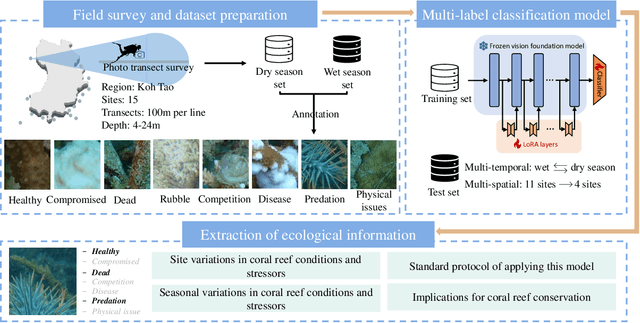

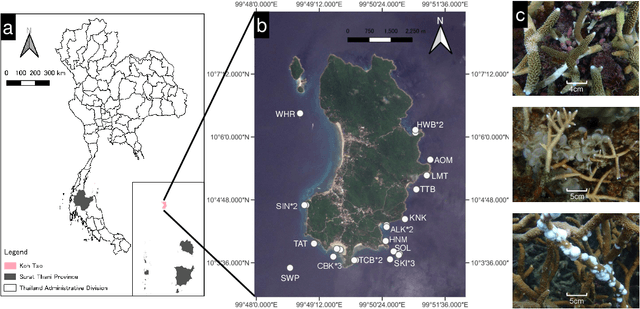
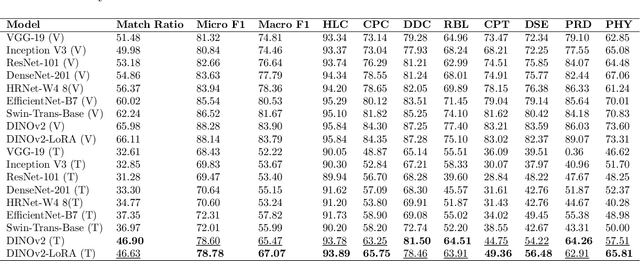
Abstract:Coral reef ecosystems provide essential ecosystem services, but face significant threats from climate change and human activities. Although advances in deep learning have enabled automatic classification of coral reef conditions, conventional deep models struggle to achieve high performance when processing complex underwater ecological images. Vision foundation models, known for their high accuracy and cross-domain generalizability, offer promising solutions. However, fine-tuning these models requires substantial computational resources and results in high carbon emissions. To address these challenges, adapter learning methods such as Low-Rank Adaptation (LoRA) have emerged as a solution. This study introduces an approach integrating the DINOv2 vision foundation model with the LoRA fine-tuning method. The approach leverages multi-temporal field images collected through underwater surveys at 15 dive sites at Koh Tao, Thailand, with all images labeled according to universal standards used in citizen science-based conservation programs. The experimental results demonstrate that the DINOv2-LoRA model achieved superior accuracy, with a match ratio of 64.77%, compared to 60.34% achieved by the best conventional model. Furthermore, incorporating LoRA reduced the trainable parameters from 1,100M to 5.91M. Transfer learning experiments conducted under different temporal and spatial settings highlight the exceptional generalizability of DINOv2-LoRA across different seasons and sites. This study is the first to explore the efficient adaptation of foundation models for multi-label classification of coral reef conditions under multi-temporal and multi-spatial settings. The proposed method advances the classification of coral reef conditions and provides a tool for monitoring, conserving, and managing coral reef ecosystems.
BRIGHT: A globally distributed multimodal building damage assessment dataset with very-high-resolution for all-weather disaster response
Jan 10, 2025



Abstract:Disaster events occur around the world and cause significant damage to human life and property. Earth observation (EO) data enables rapid and comprehensive building damage assessment (BDA), an essential capability in the aftermath of a disaster to reduce human casualties and to inform disaster relief efforts. Recent research focuses on the development of AI models to achieve accurate mapping of unseen disaster events, mostly using optical EO data. However, solutions based on optical data are limited to clear skies and daylight hours, preventing a prompt response to disasters. Integrating multimodal (MM) EO data, particularly the combination of optical and SAR imagery, makes it possible to provide all-weather, day-and-night disaster responses. Despite this potential, the development of robust multimodal AI models has been constrained by the lack of suitable benchmark datasets. In this paper, we present a BDA dataset using veRy-hIGH-resoluTion optical and SAR imagery (BRIGHT) to support AI-based all-weather disaster response. To the best of our knowledge, BRIGHT is the first open-access, globally distributed, event-diverse MM dataset specifically curated to support AI-based disaster response. It covers five types of natural disasters and two types of man-made disasters across 12 regions worldwide, with a particular focus on developing countries where external assistance is most needed. The optical and SAR imagery in BRIGHT, with a spatial resolution between 0.3-1 meters, provides detailed representations of individual buildings, making it ideal for precise BDA. In our experiments, we have tested seven advanced AI models trained with our BRIGHT to validate the transferability and robustness. The dataset and code are available at https://github.com/ChenHongruixuan/BRIGHT. BRIGHT also serves as the official dataset for the 2025 IEEE GRSS Data Fusion Contest.
Underwater litter monitoring using consumer-grade aerial-aquatic speedy scanner (AASS) and deep learning based super-resolution reconstruction and detection network
Aug 07, 2024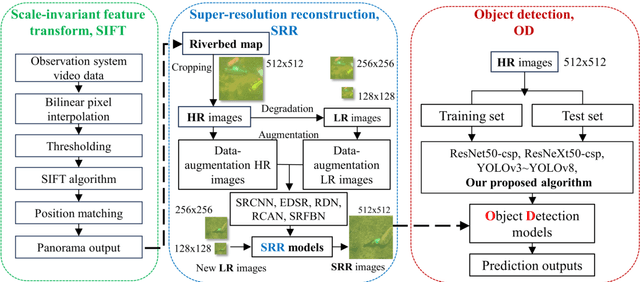

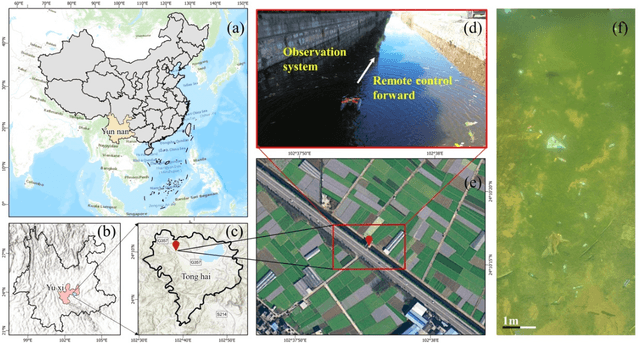

Abstract:Underwater litter is widely spread across aquatic environments such as lakes, rivers, and oceans, significantly impacting natural ecosystems. Current monitoring technologies for detecting underwater litter face limitations in survey efficiency, cost, and environmental conditions, highlighting the need for efficient, consumer-grade technologies for automatic detection. This research introduces the Aerial-Aquatic Speedy Scanner (AASS) combined with Super-Resolution Reconstruction (SRR) and an improved YOLOv8 detection network. AASS enhances data acquisition efficiency over traditional methods, capturing high-quality images that accurately identify underwater waste. SRR improves image-resolution by mitigating motion blur and insufficient resolution, thereby enhancing detection tasks. Specifically, the RCAN model achieved the highest mean average precision (mAP) of 78.6% for detection accuracy on reconstructed images among the tested SRR models. With a magnification factor of 4, the SRR test set shows an improved mAP compared to the conventional bicubic set. These results demonstrate the effectiveness of the proposed method in detecting underwater litter.
Deep learning for multi-label classification of coral conditions in the Indo-Pacific via underwater photogrammetry
Mar 12, 2024



Abstract:Since coral reef ecosystems face threats from human activities and climate change, coral conservation programs are implemented worldwide. Monitoring coral health provides references for guiding conservation activities. However, current labor-intensive methods result in a backlog of unsorted images, highlighting the need for automated classification. Few studies have simultaneously utilized accurate annotations along with updated algorithms and datasets. This study aimed to create a dataset representing common coral conditions and associated stressors in the Indo-Pacific. Concurrently, it assessed existing classification algorithms and proposed a new multi-label method for automatically detecting coral conditions and extracting ecological information. A dataset containing over 20,000 high-resolution coral images of different health conditions and stressors was constructed based on the field survey. Seven representative deep learning architectures were tested on this dataset, and their performance was quantitatively evaluated using the F1 metric and the match ratio. Based on this evaluation, a new method utilizing the ensemble learning approach was proposed. The proposed method accurately classified coral conditions as healthy, compromised, dead, and rubble; it also identified corresponding stressors, including competition, disease, predation, and physical issues. This method can help develop the coral image archive, guide conservation activities, and provide references for decision-making for reef managers and conservationists. The proposed ensemble learning approach outperforms others on the dataset, showing State-Of-The-Art (SOTA) performance. Future research should improve its generalizability and accuracy to support global coral conservation efforts.
 Add to Chrome
Add to Chrome Add to Firefox
Add to Firefox Add to Edge
Add to Edge